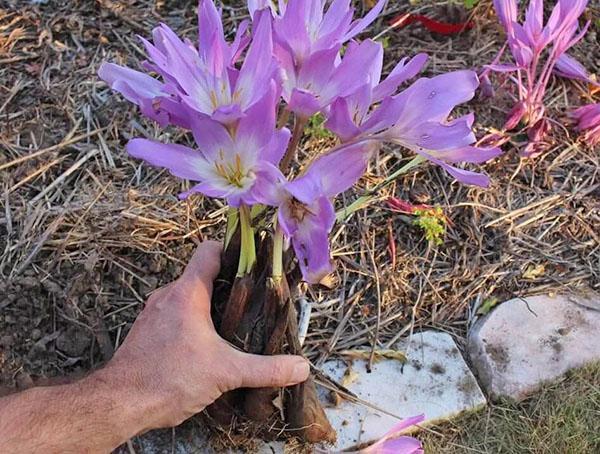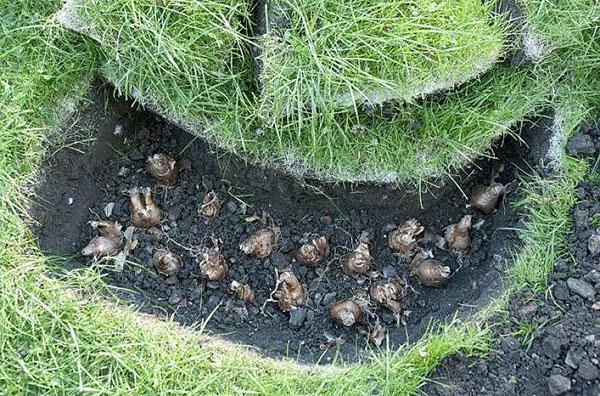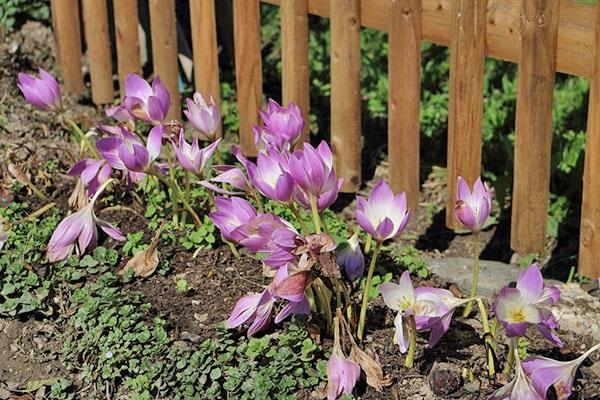Easy planting and caring for the crocus on the site
 All species of this genus are poisonous plants, especially leaves and seeds. Therefore, planting and caring for the crocus should be carried out with gloves. Many varieties and hybrids are bred in gardens and backyards as ornamental plants. They are unpretentious, bloom better in sunny places, but they can also tolerate light partial shade. Fairly frost-resistant, but in harsh climates in winter, they require a little foliage cover.
All species of this genus are poisonous plants, especially leaves and seeds. Therefore, planting and caring for the crocus should be carried out with gloves. Many varieties and hybrids are bred in gardens and backyards as ornamental plants. They are unpretentious, bloom better in sunny places, but they can also tolerate light partial shade. Fairly frost-resistant, but in harsh climates in winter, they require a little foliage cover.
Colchicum - planting and care

 Planting crocus is best done near shrubs - a natural variant of snow retention. The flower prefers moist, fertile and loose soil, with the addition of compost or humus. The bulbs are planted 10-14 cm deep, depending on their size. The distance between them is the same, but if there is a large amount of planting material, you can place them denser. Then, in the first year, the blooming meadow will look magical.
Planting crocus is best done near shrubs - a natural variant of snow retention. The flower prefers moist, fertile and loose soil, with the addition of compost or humus. The bulbs are planted 10-14 cm deep, depending on their size. The distance between them is the same, but if there is a large amount of planting material, you can place them denser. Then, in the first year, the blooming meadow will look magical.
A distinctive feature of the plant is its flowering in late autumn in a leafless state.
If planting and caring for the crocus was not possible in August, you can do it later - all the same, he will have time to please with his flowering in the same autumn. Since the plant is unpretentious, it can be planted in the ground, simply by removing the soil and sprinkling the bulbs with fertile soil. Fresh flowers on the lawn will look beautiful.
After 4 years, an autumn crocus transplant will be required in the spring with the simultaneous separation of the children. As with all bulbs, bulbs can become very deep within a few years. To prevent this from happening, the planting material should be placed in mesh flat baskets and planted in this form in the ground.
Care features

Planting and leaving the crocus is best done as follows:
- After the foliage turns yellow, the plant begins a dormant period (midsummer).
- Children are separated and all planting material is dried. Sick and rotten bulbs are discarded.
- In August, they are planted in a permanent place of growth. Moreover, the children are placed separately.
 Autumn planting and cultivation of colchicum (colchicum) is carried out both with the use of fertilizers (40 g of nitrophoska per 1 sq. M.) And without them.
Autumn planting and cultivation of colchicum (colchicum) is carried out both with the use of fertilizers (40 g of nitrophoska per 1 sq. M.) And without them.
In ancient Greece, it was believed that this flower was formed from drops of Prometheus' blood. Ancient Russians called it a winter road, an autumn road and a dog's bow. The British also called it - a naked lady.
The set of measures for plant care is minimized, but the basic procedures should still be performed:
- Watering is carried out during flowering every other day, subject to hot and dry weather. The plant does not tolerate excess moisture.
- Fertilizer is used as a top dressing in spring, but this technique is optional.
- Weeding prolongs the flowering time, as does the timely removal of faded buds and seed pods in the spring.
- Preparation for winter consists in covering the plantings with non-woven material or humus a layer of 10-14 cm.
Planting and caring for a crocus in the open field also includes timely loosening after watering and mulching.
The leaves of kolchikum cannot be cut off - they turn yellow and dry on their own.
In the spring, the non-woven shelter is removed, and the compost, humus or dry foliage is carefully raked.
Diseases and pests
 In conditions of high humidity, young leaves are affected by gray rot. In this case, you should reduce watering and treat the plants with fungicides ("Topaz", "Champion", etc.). In case of mass defeat, diseased elements are removed and burned.
In conditions of high humidity, young leaves are affected by gray rot. In this case, you should reduce watering and treat the plants with fungicides ("Topaz", "Champion", etc.). In case of mass defeat, diseased elements are removed and burned.
For succulent leaves, slugs and snails are a great threat. They are harvested by hand and sprinkled around the plants and soil. wood ash.
Types and varieties
Not all species bloom in the fall, there are varieties and hybrids that bloom in the spring:
- Yellow. One to three yellow flowers up to 3 cm in diameter and up to 14 cm in height bloom together with leaves in April-May. Leaves 9-14 mm wide, 15-20 cm long.

- Hungarian variety Velebit Star. It blooms immediately after the snow melts with white flowers with burgundy anthers. The edges of the leaf blade are slightly pubescent.

- Ankara. Distributed in the Crimea and several regions of Moldova. Flowering can occur between January and April. Up to 7 peduncles can form from one bulb. The flowers have 3 petals, so the plant is also called three-leafed.

- Regel. Withstands cold up to -22 degrees, blooms immediately after the snow melts. Leaves are lanceolate, obtuse, from 2 cm long at the beginning of the growing season to 7-9 cm by the end. Funnel-shaped flowers up to 4 pcs. on one onion. Anthers yellow, white flowers with a burgundy stripe outside.

- Water-loving. It blooms in pink, white-pink, lilac or purple hues in early spring. One bulb develops from 3 to 7 flowers with long (up to 3 cm) petals, slightly curved inward. Leaves are pointed lanceolate.

- Colchicum tuberous. Plant height ranges from 10 to 21 cm. The leaves are grooved, with pointed ends, up to 18 cm long. Flowers are arranged in bunches of several pieces of pink or white color. Leaves and flowers appear simultaneously after the snow melts.

Of the autumn blooming, the following are the most interesting:
- Terry. Lilac flowers with many (up to 34 pcs.) Long (up to 13 cm) petals and a diameter of 5-6 cm. Dark green leaves reach 26 cm in length and 5 cm in width. Flowering occurs at the end of October.

- Motley. A perennial plant reaches a height of 28-32 cm. Creeping leaves 14-16 cm long. Flowers are arranged in several pieces on one stem of pink, purple or purple shades with a checkerboard pattern.

Colchicum is a real find for the garden. In early spring and late autumn, when there are still or no bright colors, these unpretentious flowers will delight the eye and remind you of summer.